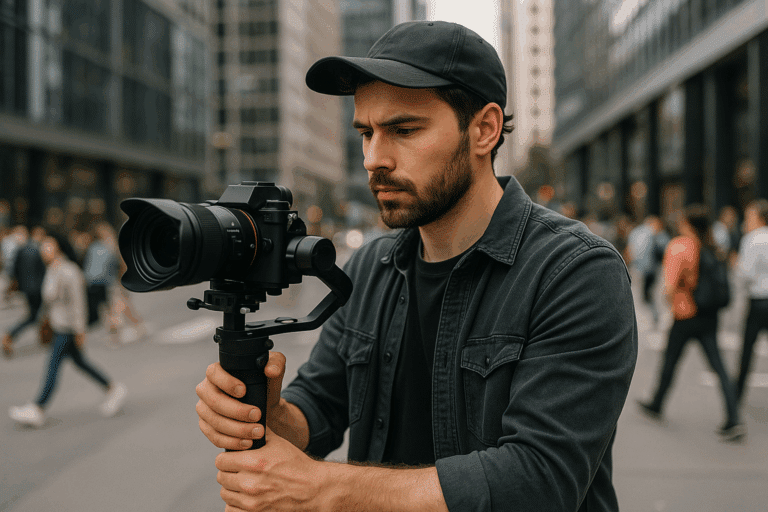In the realm of digital storytelling, where eye-catching visuals reign supreme, mastering the art of slow motion can elevate your content to a whole new level. This technique, once reserved for high-end video production, is now at your fingertips, thanks to the technology built into your smartphone. 📱
With the sheer power of mobile devices today, anyone can create stunning slow-motion videos without needing a film degree or expensive equipment. A simple trick here and a little tweak there can lead to results that make your content stand out from the crowd. Whether you are a vlogger aiming for more views, a marketer striving for impactful promotional content, or simply an enthusiast looking to capture mesmerizing moments, this article is just for you.
The Power of Slow Motion
Slow motion isn’t merely a stylistic choice; it’s a powerful tool that can bring out the subtlety and intricacies of a scene that might otherwise go unnoticed. 🐌 It can add drama, highlight the beauty of a single moment, or emphasize the power and intensity of an action. With the right planning and execution, slow-motion can transform an ordinary scene into an extraordinary visual spectacle.
Slow-Mo Techniques: Simplified for Your Phone
While professional videographers often use complex equipment and software to achieve slow-motion effects, the modern smartphone camera, coupled with the right techniques, can produce equally stunning results. We will delve deep into the basics of frame rate and shutter speed, explaining how these fundamental parameters influence your slow-motion video quality and how to adjust them for the best possible output.
Post-Production: Enhancing Your Slow-Mo Footage
But it doesn’t end with just recording. A well-executed slow-motion video is as much about the post-production work as it is about the shooting process. We will guide you through the process of editing your slow-motion footage, providing insights on how to best utilize apps and software to fine-tune your content, from adjusting the playback speed to adding the perfect soundtrack. 🎵
Our goal is to help you navigate the intricacies of slow-motion videography and, in doing so, unlock your smartphone’s full potential. By the end of this article, you will have all the knowledge and tools you need to create stunning slow-motion videos right from your phone.
A Journey through the Art of Slow-Motion
From understanding the physics of slow motion to exploring the best apps for slow-mo video editing, we will take you on a comprehensive journey through the art of slow-motion videography. You’ll discover the secrets of creating compelling content that captivates your audience and makes a lasting impact. 🚀
So, are you ready to delve into the world of slow-motion videography and learn how to create breathtaking slow-motion videos on your phone? Let’s get started.
Master the Art of Slow-Mo: Your Key to Producing Magnificent Mobile Videos
With the advancement in technology, smartphones have become an indispensable tool for creating breathtaking visuals. Slow-motion videos, in particular, have become a popular and creative way to capture life’s most exciting moments. However, the art of slow-motion video creation requires more than just pressing the record button on your phone. It involves understanding the science behind frame rates, mastering the timing of the shot, and knowing how to play with light and motion. This article dives deep into the art of slow-motion videography and provides practical tips to help you create stunning videos on your phone.
Understanding Frame Rates: The Building Blocks of Video
Before we dive into how to create slow-motion videos, let’s take a quick detour to understand the concept of frame rates. In essence, a video is just a series of still images, or frames, displayed at a high speed. The frame rate, measured in frames per second (fps), dictates how many of these images your camera captures each second. Standard videos are typically shot at 24-30 fps. However, to achieve the slow-motion effect, you need to capture at a much higher frame rate, typically at 120 or 240 fps, depending on your device.
Shooting Slow-Motion Videos: Technique Matters
Now that we’ve covered the basics of frame rates, let’s dive into the techniques for capturing slow-motion videos. Shooting a slow-motion video isn’t just about setting the right frame rate on your phone. It also involves knowing when to start and stop the slow motion, how to manage lighting, and how to create motion that looks interesting when slowed down.
A Step-By-Step Guide to Creating Slow-Motion Videos
To help you capture stunning slow-motion videos on your phone, here’s a step-by-step guide that covers everything from setting up your phone to post-processing the footage.
1. Choose the Right Environment
When shooting slow-motion videos, lighting is paramount. A well-lit environment will reduce noise and ensure that your footage looks crisp and clear. Avoid shooting in low-light conditions, as this can cause your footage to look grainy and blurry.
2. Set Your Phone to the Highest Frame Rate
As discussed earlier, slow-motion videos require a high frame rate. On your phone, navigate to the camera settings and select the highest available frame rate, typically 120 or 240 fps. Remember, the higher the frame rate, the slower the motion will be.
3. Plan Your Shot
Planning your shot beforehand can make the difference between a good video and a great one. Think about what action you want to capture, how you can create interesting motion, and when you’ll start and stop the slow motion.
Enhancing Your Slow-Motion Videos: Post-Processing Tips
Once you’ve captured your slow-motion video, the work isn’t over. Post-processing is a crucial step in creating a polished final product. Let’s look at some ways you can enhance your slow-motion videos during post-processing.
1. Use Editing Software
There are numerous video editing software options available, both for computers and smartphones. These tools can help you adjust the speed of your video, trim unwanted parts, add effects, and more. Some popular options include Adobe Premiere Pro, Final Cut Pro, and iMovie.
2. Add Music
Adding music to your slow-motion video can enhance the viewing experience and help convey the mood you’re trying to create. Choose a song that matches the speed and tone of your video, and use your editing software to sync the music with the action.
3. Experiment with Speed Ramping
Speed ramping is a technique that involves changing the speed of your footage to add emphasis to certain parts. You can use this technique to make your slow-motion videos more dynamic and engaging.
Comparing Slow-Mo Capabilities: Top Smartphones of 2021
Not all smartphones are created equal when it comes to slow-motion capabilities. Let’s take a look at some of the top smartphones of 2021 and how they stack up in terms of slow-motion videography.
| Phone Model | Max Frame Rate | Resolution |
|---|---|---|
| iPhone 13 Pro | 240 fps | 1080p |
| Samsung Galaxy S21 Ultra | 960 fps | 720p |
| Google Pixel 6 Pro | 240 fps | 720p |
Check out the video below for a detailed comparison and demonstration of these phones’ slow-motion capabilities.
Video Title: Slow Motion Comparison: iPhone 13 Pro vs Samsung Galaxy S21 Ultra vs Google Pixel 6 Pro
Channel: SuperSaf TV
Wrapping Up: Practice Makes Perfect
Mastering the art of slow-motion videography takes time, patience, and practice. But with the tips and techniques provided in this article, you’re well on your way to creating stunning slow-motion videos on your phone. So get out there, start experimenting, and let your creativity shine.

Conclusion
In wrapping up our discussion on complex algorithms, software architecture, and the role of data science in modern technology, it’s important to underline the key points we’ve covered. We’ve delved deep into the intricacies of computer programming, discussing not only the theoretical aspects but also practical applications. We’ve navigated the fundamentals of object-oriented programming, dissected the layers of data modeling, and explored the expansive realm of data science. 🚀
In the realm of programming, we’ve discovered the transformative power of algorithms, their various forms, and how they’re applied in creating efficient systems. This knowledge is crucial, as algorithms are the backbone of any functional software. It’s not just about writing code, but writing efficient, effective, and maintainable code. 👩💻👨💻
We’ve also tackled the often daunting world of software architecture. By understanding the different architectural patterns such as MVC, MVP, and MVVM, we can appreciate how software components interact and coexist. Remember that good architecture is not about creating rigid rules, but establishing a flexible framework that accommodates change and growth. 💡🏛️
Our journey also took us through the dynamic landscape of data science, a field that stands at the intersection of statistics, computer science, and domain knowledge. The insights we gain from data can drive better decision making, optimize processes, and even uncover new opportunities. The potential is immense, and it is up to us to unlock it. 📊🔑
In the grand scheme of things, these concepts interlock to create the tapestry of modern technology. They underline the importance of continuous learning and innovation in the world of tech. While these concepts can be challenging, I believe in the power of shared knowledge and the importance of demystifying complex topics.
If you have any questions, thoughts, or insights, feel free to leave a comment. If you found this article helpful, please share it with others. After all, learning is an ongoing process, and it’s best when it’s a shared journey. Let’s continue to learn, innovate, and make the tech world a better place, one algorithm at a time. 💪🌐
Finally, if you’re looking to delve deeper into these topics, I highly recommend these sources:
1. Algorithm – Wikipedia
2. Software architecture – Wikipedia
3. Data science – Wikipedia
They offer a wealth of information and are an excellent starting point for further exploration.
Remember, as Albert Einstein once said, “The more I learn, the more I realize how much I don’t know.” Let’s keep learning and discovering together. 🎓🚀


